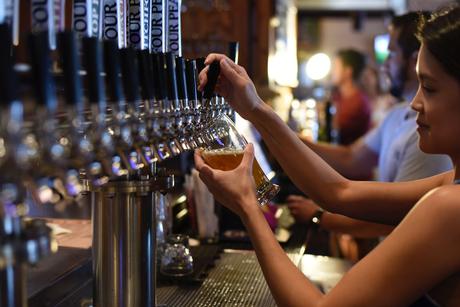
Photo by ELEVATE on Pexels.com
" data-orig-size="1880,1255" data-image-title="pan holding pilsner inside bar" data-orig-file="https://sprbrewcrew.files.wordpress.com/2023/08/pexels-photo-1267360.jpeg" data-image-description="" data-image-meta="{"aperture":"0","credit":"","camera":"","caption":"","created_timestamp":"0","copyright":"","focal_length":"0","iso":"0","shutter_speed":"0","title":"","orientation":"0"}" data-medium-file="https://sprbrewcrew.files.wordpress.com/2023/08/pexels-photo-1267360.jpeg?w=300" data-permalink="https://atlbeerguyblog.com/2023/08/02/the-soaring-price-of-beer/pexels-photo-1267360/" alt="" class="wp-image-6634" data-large-file="https://sprbrewcrew.files.wordpress.com/2023/08/pexels-photo-1267360.jpeg?w=645" />Photo by ELEVATE on Pexels.comRaise your glasses, beer lovers, but don’t be surprised if you have to reach a little deeper into your wallet to quench your thirst for a cold one these days. The high price of beer has become a growing concern for consumers and aficionados alike, leaving many to wonder why their favorite beverage has become so expensive.
At the heart of every beer lies the essential ingredients: hops and barley. Both of these crops are sensitive to weather fluctuations and changes in climate patterns, making them susceptible to supply constraints. In recent years, extreme weather events, such as droughts and floods, have wreaked havoc on hops and barley crops in various regions, leading to decreased yields and increased production costs for breweries. Consequently, brewers are forced to pass on these additional expenses to consumers in the form of higher prices.
The logistics behind getting beer from breweries to store shelves also play a significant role in driving up prices. Fluctuations in fuel prices directly impact transportation costs, making it more expensive to move beer from production facilities to distribution centers and retail outlets. Moreover, the COVID-19 pandemic exposed vulnerabilities in global supply chains, causing disruptions that affected breweries’ access to raw materials and led to production delays. These setbacks, combined with increased transportation expenses, have contributed to the surging prices of beer.
The craft beer revolution has undoubtedly enriched the beer scene with innovative and flavorful brews. However, this rise in demand for craft beer has resulted in the need for premium-quality ingredients, which often come at a higher price. Small-batch breweries tend to prioritize unique and locally sourced ingredients to create distinct flavors, driving up production costs. While craft beer enthusiasts are willing to pay a premium for these one-of-a-kind brews, it has also influenced the overall beer market, causing an uptick in prices across the board.
Governments worldwide impose excise taxes on alcoholic beverages, and beer is no exception. The varying rates of taxation from one country to another and even between states in some countries can significantly impact the retail price of beer. Additionally, stringent regulations in certain regions, such as labeling requirements and alcohol content restrictions, may necessitate costly adjustments in production processes. These compliance-related expenses ultimately get passed on to consumers.
In the highly competitive world of beer, marketing and branding are vital to capture consumers’ attention. Breweries often invest substantial funds in advertising, packaging design, and promotional events to establish their brand identity and secure a loyal customer base. These expenditures are factored into the final retail price, pushing up the cost of beer for the end consumer.
The people behind the brewing process are critical to the final product’s quality and taste. Skilled brewers, technicians, and other staff involved in production require fair wages, and breweries must shoulder these costs as part of their business operations. Furthermore, breweries have to adhere to stringent quality control standards and invest in modern equipment and technology to maintain consistent product quality. As labor and production costs rise, so do the prices of the beer on store shelves.
Over the past decade, consumers’ preferences have shifted towards premium and craft beers, which often come with a higher price tag. As more individuals are willing to pay extra for a unique and superior drinking experience, breweries have seized the opportunity to introduce a diverse range of higher-priced beer offerings. This evolving consumer demand has become an influential factor in the overall increase in beer prices.
The high price of beer is the culmination of a multitude of factors at play within the beer industry. From the impact of climate change on essential ingredients like hops and barley to the complexities of the supply chain and increased production costs, all these elements have contributed to the upward trajectory of beer prices. Additionally, factors like craft beer’s popularity, taxation and regulations, marketing expenses, and changing consumer preferences further compound the situation.
As we continue to enjoy our beloved beers, it’s essential to be aware of the economic realities that shape their prices. While the cost of beer may seem steep at times, the passion and craftsmanship that go into each brew are a testament to the dedication of brewers worldwide. So, next time you raise your glass, savor every sip, and toast to the art and science behind that frothy, delightful beverage we all love. Cheers!
